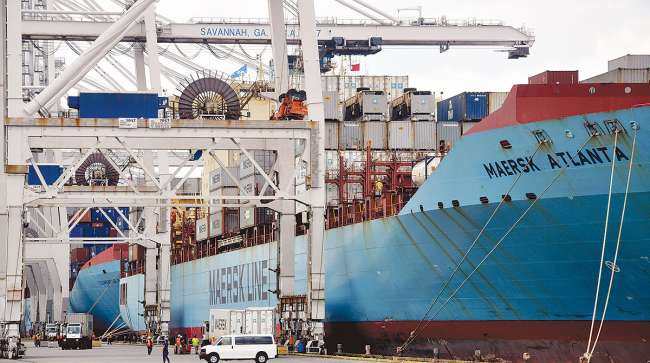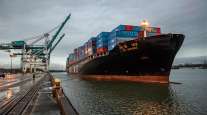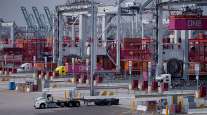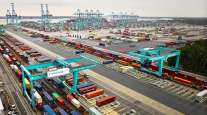Senior Reporter
East Coast Ports Gain Market Share

[Stay on top of transportation news: Get TTNews in your inbox.]
Ports on the East Coast are enjoying an uptick in volume thanks to infrastructure improvements, expanded sea routes and the positive effects that the United States’ ongoing trade war with China are having for other countries, while these same factors are contributing to drop-offs for West Coast ports that as recently as last year were reporting record levels of activity.
“Cargo shippers have been shifting their sourcing of certain commodities from China to Southeast and Southwest Asian countries,” Mercator International Senior Vice President Steve Rothberg told Transport Topics. “Many of the East Coast ports have lower port charges, lower terminal charges than West Coast ports and ocean carriers — being under pressure — find themselves more inclined to favor those routes. They’re using the lower cost East Coast ports.”
We've hit another milestone: Total volume at the Port of New York and New Jersey for September 2019 was 624,961 TEUs (352,098 lifts) versus 603,034 TEUs (341,676 lifts) in September 2018, a 3.6 percent increase. Learn more: https://t.co/A4yJcE8p5r pic.twitter.com/OYLbrLLXl0
— Port of NY & NJ (@PortNYNJ) November 14, 2019
The Port of New York and New Jersey on Nov. 25 announced that it processed a record 666,381 20-foot-equivalent containers, or TEUs, in October, a 1.1% monthly increase compared with 658,708 TEUs last year. Port officials told TT that for the first 10 months of 2019 the facility has handled 6,286,762 TEUs, up 5% compared to 2018’s 5,986,518. Those figures reflect another yearly record-setting pace.
East Coast facilities are taking advantage of new sea routes created by the recent expansions of both the Panama Canal and the Suez Canal. Some facilities have spent billions of dollars on infrastructure improvements so they can handle the larger cargo ships that can come though both channels.
Since the Suez Canal’s widening was completed in 2016, Rothberg noted that more shippers are using it to navigate into the Mediterranean Sea and through the Atlantic Ocean, skipping the journey across the Pacific. Also in 2016, an expansion of the Panama Canal permitted access to the largest cargo ships in the world, known as Neopanamax ships.
Plus, East Coast ports are seeing an increased cargo volume from nations such as India, Thailand, Indonesia and Vietnam, as those nations gain new manufacturing jobs, often at the expense of China.
“We’re beginning to feel the far-reaching effects of the U.S.-China trade war on American exporters and manufacturers,” said Port of Los Angeles Executive Director Gene Seroka. “We expect soft volumes in the months ahead and with the holiday season upon us, less cargo means fewer jobs for American workers. We need a negotiated settlement and the tariffs lifted.”
A trade study released by #PortofLA today shows tariffs threaten nearly 1.5 million U.S. jobs and more than $186 billion of economic activity nationwide, based on the impact of tariffs levied on cargo handled by the nation’s busiest container port complex. https://t.co/RP0rUXu9un pic.twitter.com/GQ0Iyw56Yd — Port of Los Angeles (@PortofLA) November 12, 2019
The Port of L.A. — the nation’s busiest port — saw container volume fall by 19.1% in October to 770,188 TEUs from 952,553 in 2018.
Volume is also down at the Port of Long Beach. October volume was down 2.4% to 688,425 containers, compared with 705,408 last year. Even with the dip, however, it was the second-busiest October in the facility’s 108-year history.
“As the trade war lingers, these tariffs continue to impact the U.S. economy and have created uncertainty for the business of importers and exporters,” port Executive Director Mario Cordero said.
It’s a different story along the East Coast. The Port of Savannah had a record October, processing 428,382 TEUs, an increase of 3.5% from 2018’s record-shattering 413,778.
#JUSTANNOUNCED: Georgia Ports marks best October ever, moving 428,400 twenty-foot equivalent container units, an increase of 14,600 TEUs or 3.5 percent. Details: https://t.co/U3J0f9eu69. #georgiaports #gaports #Savannah #PortofSavannah #cargo #logistics #shipping pic.twitter.com/5rRsuLPlUw — Georgia Ports (@GaPorts) November 14, 2019
“Georgia’s market share continues to expand as new commodities come online and customers in new regions rely on our services,” Georgia Port Executive Director Griff Lynch said.
The Savannah facility is in the middle of a multimillion-dollar expansion that aims to double capacity during the next 10 years. In October, Savannah also saw a 7.8% increase in roll-on/roll-off cargo — such as cars, farm equipment and other wheeled cargo — and the port is now the second busiest in the country for roll-on/roll-off cargo, only behind the Port of Baltimore.
Container volume at the Port of Charleston was flat in October, but year-to-date the facility is running 7% ahead of 2018’s record pace with volume of 2,063,375 TEUs compared with 1,927,971 in the year-ago period.
The Charleston and other Southeast ports are seeing an increase in business because automaker BMW said it shipped more than $8.4 billion worth of luxury autos built at its South Carolina BMW plant to foreign countries in 2018.
The Port of Virginia saw its October TEU numbers drop by 1.3% to 266,976 from 270,538 in 2018, but the facility is running nearly 5% ahead of 2018 and is on track for its fifth record-setting year.
“We continue to see the impact of the tariffs on some of our agricultural exports that would normally be heading to China and this will continue until both sides reach a compromise on that issue,” Port CEO John Reinhart said. “Additionally, export markets are feeling the effect of the strong dollar. The increased cost overseas of American-made goods creates a challenge for exporters.”#
Want more news? Listen to today's daily briefing:




